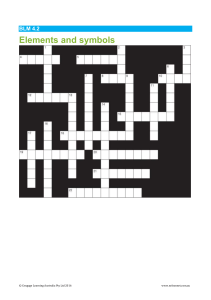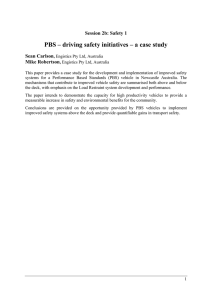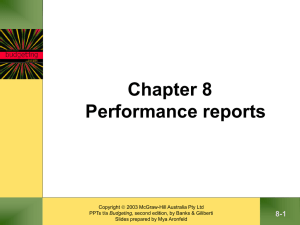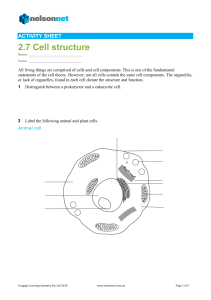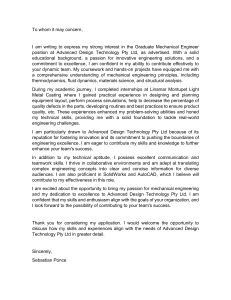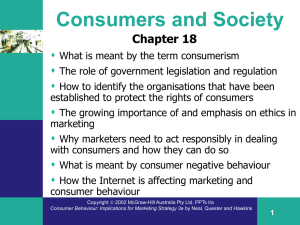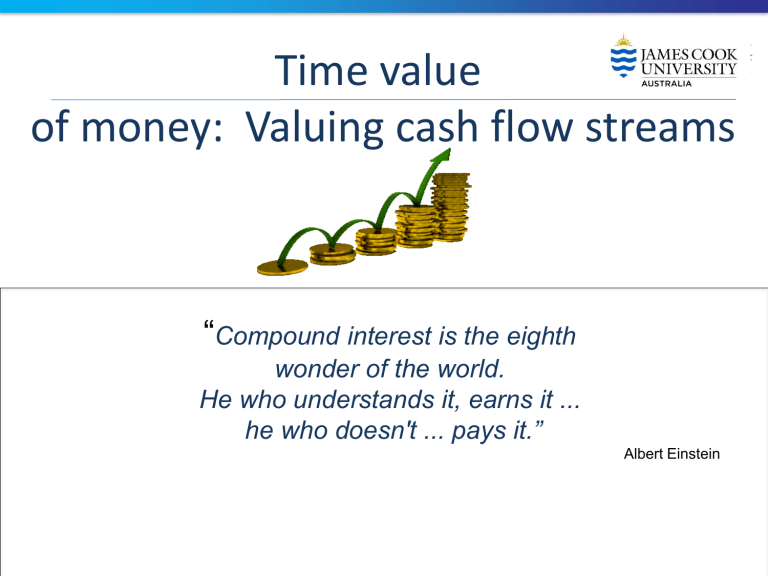
Time value of money: Valuing cash flow streams “Compound interest is the eighth wonder of the world. He who understands it, earns it ... he who doesn't ... pays it.” Albert Einstein Learning objectives • Value a series of many cash flows. • Value a perpetual series of regular cash flows called a perpetuity. • Value a common set of regular cash flows called an annuity. • Value both perpetuities and annuities when the cash flows grow at a constant rate. • Calculate the number of periods, cash flow, or rate of return of a loan or investment. 2 Finance way of thinking • Problem solving process – Timelines – Positing, doing, checking • Disciplinary understandings – Interpreting your results / making sense of your answer • Rearranging formulae – Very basic level Terms • Interest rate, discount rate, yield, return r • Value, cash flow, cost, inflow • Term, time, period t Time Line of Cash Flows: Making it easy •Tick marks at ends of periods • Time 0 is today; • Time 1 is the end of Period 1 0 CF0 r% 1 2 CF1 CF2 Copyright 2011 McGraw-Hill Australia Pty Ltd PPTs t/a Essentials of Corporate Finance 2e by Ross et al 3 4-7 Looking forward • What is the future value of an amount? – Suppose you invest $100 for one year at 10% (r) per year. What is the future value in one year? • Interest = 100(.1) = $10 • Value in one year = principal + interest = 100 + 10 = $110 • Future Value (FV) = 100(1 + 0.1) = $110 – Suppose you leave the money in for another year. How much will you have two years from now? • FV = 100(1.1)(1.1) = 100(1.1)2 = $121 Future Values: Effects of Compounding • Simple interest – Interest earned only on the original principal • Compound interest – Interest earned on principal and on interest received – “Interest on interest” – interest earned on reinvestment of previous interest payments Copyright 2011 McGraw-Hill Australia Pty Ltd PPTs t/a Essentials of Corporate Finance 2e by Ross et al 4-9 Future Values: Effects of Compounding • Consider the previous example – FV w/simple interest = 100 + 10 + 10 = 120 – FV w/compound interest =100(1.10)2 = 121.00 – The extra 1.00 comes from the interest of .10(10) = 1.00 earned on the first interest payment Copyright 2011 McGraw-Hill Australia Pty Ltd PPTs t/a Essentials of Corporate Finance 2e by Ross et al 4-10 10% Amount Year invested Interest balance 0 100.00 10.00 110.00 1 110.00 11.00 121.00 170,00 2 121.00 12.10 133.10 160,00 3 133.10 13.31 146.41 4 146.41 14.64 161.05 150,00 140,00 130,00 120,00 110,00 Interest 100,00 Amount invested 90,00 1 2 3 4 5 The effect on FV of increasing r • Lets do a few computations – What is the value of $100 in 10 years time at: • • • • 5% 10% 15% 20% Future values $100 Discount rate Time 0% 5% 0 100 100 1 100 105.00 2 100 110.25 3 100 115.76 4 100 121.55 5 100 127.63 6 100 134.01 7 100 140.71 8 100 147.75 9 100 155.13 10 100 162.89 10% 100 110.00 121.00 133.10 146.41 161.05 177.16 194.87 214.36 235.79 259.37 15% 100 115.00 132.25 152.09 174.90 201.14 231.31 266.00 305.90 351.79 404.56 20% 100 120.00 144.00 172.80 207.36 248.83 298.60 358.32 429.98 515.98 619.17 700 Future value of $1 600 500 0% 5% 10% 15% 20% 400 300 200 100 0 0 5 10 15 Future Value Interest Factors Page 562 Appendix A Future value – single sums If you deposit $100 in an account earning 6% pa, how much would you have in the account after 1 year? PV = 100 0 FV = ??? 106 1 Future value – single sums If you deposit $100 in an account earning 6% pa, how much would you have in the account after 5 years? PV = 100 FV = ??? 133.82 0 5 solution FV = PV (1 + r )t = 100 ( 1 + 0.06 )5 = 100 x 1.3382 = 133.82 Future value – quarterly compounding If you deposit $100 in an account earning 6% pa with quarterly compounding, how much would you have in the account after 5 years? PV = 100 134.69 FV = ??? 0 5 solution t = 5 x 4 = 20 periods r = 6 / 4 = 1.5% per period FV = 100*(1+0.015)^20 = 134.69 Future Values: General Formula • FV = PV(1 + r)t FV = future value PV = present value r = period interest rate, expressed as a decimal T = number of periods • Future value interest factor = (1 + r)t FVIF(r,t) = Future Value Interest Factor for $1 invested at r% for t periods. Copyright 2011 McGraw-Hill Australia Pty Ltd PPTs t/a Essentials of Corporate Finance 2e by Ross et al 4-18 Present Value FV = PV(1 + r)t FV / (1+r)t = PV PV = FV / (1+r)t Which is equivalent to PV = FV(1+r)-t • “Discounting” = finding the present value of one or more future amounts • (1+r)-t is the present value factor Copyright 2011 McGraw-Hill Australia Pty Ltd PPTs t/a Essentials of Corporate Finance 2e by Ross et al 4-19 Single sums If you will receive $100 in one year from now, what is its present value if your opportunity cost is 6%? PV = ??? 94.34 0 FV = 100 1 solution or PV = FV / ( 1 + r )t PV = FV * ( 1 + r )-t =100 / ( 1 + 0.06 )1 =100 * ( 1.06 )-1 = 100 / 1.06 = 100 * (0.9434) = 94.34 = 94.34 Single sums If you will receive $100 in one year from now, what is its present value if your opportunity cost is 6% pa compounded quarterly? PV = ??? 94.34 0 solution PV = FV / ( 1 + r )t =100 / ( 1 + 0.015 )4 = 100 / 1.061364 = $94.22 FV = 100 1 Bringing future amounts into todays terms • Finding the present value of some future amount To reach a savings target of $3,000 after two years at 8% p.a. compounded quarterly, how much would we have to invest today? Draw a timeline and write what we know, r, t, … To reach a savings target of $3,000 after two years at 8% p.a. compounded quarterly, how much would we have to invest today? PV = $3,000 / (1.02)8 = $3,000 / 1.17166 = $2,560.47 Present Value: Important Relationship I For a given interest rate: – The longer the time period, – The lower the present value FV PV t (1 r ) For a given r, as t increases, PV decreases Copyright 2011 McGraw-Hill Australia Pty Ltd PPTs t/a Essentials of Corporate Finance 2e by Ross et al 4-24 Page 564 Discount Rate • To find the implied interest rate, rearrange the basic PV equation and solve for r: FV = PV(1 + r)t FV/PV = (1 + r)t (FV/PV) 1/t = ((1 + r)t) 1/t r = (FV / PV)1/t – 1 • If using formulas with a calculator, make sure you can use both the yx and the 1/x keys Copyright 2011 McGraw-Hill Australia Pty Ltd PPTs t/a Essentials of Corporate Finance 2e by Ross et al 4-27 If you sell a block of land for $11,933 that you bought 5 years ago for $5,000, what is your annual rate of return? PV = ??? 5,000 0 FV = 11,933 5 Calculating rates of return If you sell land for $11,933 that you bought 5 years ago for $5,000, what is your annual rate of return? Solution FV = PV * ( 1 + r )t 11933 = 5000 * ( 1 + r )5 11933 / 5000 = (1 + r )5 2.3866 = (1 + r )5 2.38661/5 =1 + r 1 + r = 1.19 r = 0.19 Calculating rates of return If you sell land for $11,933 that you bought 5 years ago for $5,000, what is your annual rate of return? Using FV table to check FV = PV * ( 1 + r )t 11933 = 5000 * ( 1 + r )5 11933 / 5000 = (1 + r )5 2.3866 = (1 + r )5 Table a1 across row n=5 we find 2.3866 is between 18 and 20 r = 19% sounds ok Calculating rates of return If you sell land for $11,933 that you bought 5 years ago for $5,000, what is your annual rate of return? Using PV table to check PV = FV ( PVIFr,t) 5000 = 11933 ( PVIFr,5 ) PVIFr,5 = 5000 / 11933 PVIFr,5 = 0.419 Table a2 across row n=5 we find 0.419 is between 18 and 20 r = 19% sounds ok Finding the Number of Periods • Start with basic equation and solve for t: FV = PV(1 + r)t FV/PV = (1 + r)t ln(FV/PV) = t ln (1 + r) FV ln PV t ln(1 r ) 4-32 Calculating n Suppose you placed $100 in an account that pays 9.6% interest, compounded monthly. How long will it take for your account to grow to $500? PV = ??? 100 0 FV = 500 ? Calculating t solution PV = 100, FV = 500, r = .096/12 = 0.008 per month FV=PV(1+r)t 500 = 100(1.008)t 500/100 = (1.008)t ln(5) = t ln(1.008) t = 202 ln(5) / ln(1.008) = t months t = 201.98 Check your understanding 1. If you had $10,000 now and could invest it for five years at 5%, and then a further 5 years at 7%, how much would you have at the end? 2. If your firm had to repay $7m in 25 years time, using a discount rate of 6%, what is the debt worth today? Check your understanding 3. You are offered an investment opportunity involving a return of $100,000 in 15 years time, on an initial investment of $50,000. What rate of return is implied?
